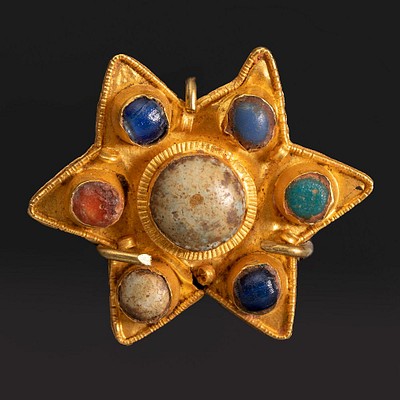ANDRÉS CORTÉS Y AGUILAR (Seville, 1812 - 1879) "Couple of Andalusian landscapes", 1858. Oil paintings on boards.
Lot 107
About Seller
Setdart Auction House
Carrer Aragó 346
Barcelona
Spain
Setdart Subastas was born in 2004 and is currently the first online art auction in Spain with solidity, prestige and reliability guaranteed by our more than 60,000 users. Setdart has a young, dynamic and enterprising team ready to successfully manage the purchase and sale of art works through custom...Read more
Estimate:
EUR€4,000 - EUR€5,000
$4,301.08 - $5,376.34
Absentee vs Live bid
Two ways to bid:
- Leave a max absentee bid and the platform will bid on your behalf up to your maximum bid during the live auction.
- Bid live during the auction and your bids will be submitted real-time to the auctioneer.
Bid Increments
| Price | Bid Increment |
|---|---|
| EUR€0 | EUR€10 |
| EUR€200 | EUR€25 |
| EUR€500 | EUR€50 |
| EUR€1,000 | EUR€100 |
| EUR€3,000 | EUR€200 |
| EUR€5,000 | EUR€500 |
| EUR€10,000 | EUR€1,000 |
| EUR€20,000 | EUR€2,000 |
| EUR€50,000 | EUR€5,000 |
About Auction
By Setdart Auction House
Dec 21, 2021
Set Reminder
2021-12-21 07:30:00
2021-12-21 07:30:00
America/New_York
Bidsquare
Bidsquare : Córdoba: 2,000 Years of Art
https://www.bidsquare.com/auctions/setdart-auction-house/c-rdoba-2-000-years-of-art-8049
Setdart Auction House sofia@setdart.com
Setdart Auction House sofia@setdart.com
- Lot Description
ANDRÉS CORTÉS Y AGUILAR (Seville, 1812 - 1879) "Couple of Andalusian landscapes", 1858. Oil paintings on boards. One of them has a signature and date in the lower right corner. Measurements: 35,5 x 49,5 cm; 44,5 x 58 cm (frame). Painter of prolific and very personal work, however there is little precise information about his life. His father, Antonio Cortés, lived in France and had been a disciple of the landscape and animal painter Constantin Troyon (1810-1865), which undoubtedly must have marked from his first artistic steps, together with his father, the preference of Andrés Cortés for painting landscapes with herds; a genre in which he would become one of the most outstanding specialists of his time, and which defines a good part of his production. Present since 1840 in Seville, where he would live all his life and strengthen his career, he was a professor at the School of Fine Arts and a member of its Academy since 1862, soon achieving fame in the Sevillian artistic circles with his attractive panoramic views of the city populated with figures, for which he is best known today, and which gave him a notable reputation in his time among the clientele of the high society of Seville. Among them, the most famous are undoubtedly his versions of The Seville Fair; the first painted for the Count of Ybarra, promoter of this popular livestock fair, and the other, signed in 1852, which is preserved in the Museum of Fine Arts in Bilbao. Within the same genre, Andrés Cortés painted other Sevillian views of equally ambitious composition, attentive both to the description of buildings and monuments and to that of the types and clothing of the characters that populate them, with a vivid and bright coloring; aspects in which lies much of its appeal, highlighting among them the View of Seville from the Prado de San Sebastián, painted in 1866 (Seville, Javier Benjumea collection). However, most of the artist's best known paintings, and with which he must have maintained his career, due to their easy sale and their decorative picturesqueness, were rural landscapes with herds, almost always sheep or cow huts guided by their shepherds, of which the following are good examples: Camino de la Feria (Seville, Count of Aguiar), Paisaje con pastores y ganado (Palma del Condado, Cepeda Collection), Paisaje de fantasía (Madrid, Fundación Santamarca), and the landscapes with figures in the Carmen Thyssen-Bornemisza Collection. He also painted some discreet portraits, such as those of Nicolás Antonio (Seville, Biblioteca Colombina), signed in 1851; José María Ybarra (Seville, Count of Ybarra), a work from 1854; and that of Rodrigo Ponce de León, Marquis of Cádiz (Seville, City Hall), signed two years later. He was also an interesting type painter, a facet of which El tío Gamboa de Hinojos (private collection), painted in 1857, and El Leñador se cosiéndose la ropa (Seville, private collection) are good examples. We also know of some religious paintings by his hand, such as La caridad de las Hermanas de San Vicente de Paúl (Seville, City Hall; deposited in the Hogar de la Virgen de los Reyes), painted in 1847, and we also know of a large historical canvas painted by Cortés in 1848 representing Guzmán el Bueno arming his son as a knight, which had a certain echo in the Sevillian press of the time and was acquired by the Dukes of Montpensier. Participant in the exhibitions of Fine Arts that were held in the city, in 1858 he was awarded a silver medal for A Country, presenting in 1868 A Cabin. The recognition that he enjoyed in his city filled him with local honors and distinctions, becoming a founding member of the Archaeological Deputation of Seville, president of its Arts class, correspondent of the Royal Academy of Archaeology and Geography of Prince Alfonso and of that of Cordoba, and member of the Academy of Emulation and Promotion, as well as being decorated with several crosses.
- Shipping Info
-
In-house shipping available. Please inquire at admin@setdart.com.
-
- Buyer's Premium



 EUR
EUR CAD
CAD AUD
AUD GBP
GBP MXN
MXN HKD
HKD CNY
CNY MYR
MYR SEK
SEK SGD
SGD CHF
CHF THB
THB

















